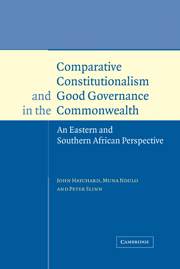INTRODUCTION
‘Commonwealth’ has been inserted into the title of this chapter for two reasons: firstly, my own work over the years has concentrated on the Anglophone countries of sub-Saharan Africa; secondly, the Commonwealth has established fundamental principles of governance against which the performance of member states may be assessed. What can the experience of other African countries teach students of South Africa's often painful constitutional journey? What general lessons, if any, emerge from the experience of African countries for those undergoing a process of transition?
A comparative perspective also calls for an historical perspective. In the history of the political and constitutional evolution of African countries in the second half of the twentieth century and the turn of the twenty-first, a number of overlapping eras of transition may be discerned. Firstly, the era of decolonisation, characterised by the ‘Wind of Change’ which began to blow in sub-Saharan Africa with the independence of Ghana in 1957. By 1975, the whole of sub-Saharan Africa was decolonised except for Southern Rhodesia (where the white minority regime of Ian Smith had made an illegal declaration of independence in 1965), South West Africa (occupied by South Africa) and, of course, South Africa itself as far as the majority of the population was concerned. Sadly, the 1970s and 1980s proved the lost decades of good governance, characterised at best by the establishment of ‘one-party states’ and at worst by the replacement of constitutional government by military regimes ruling by decree.
In the 1990s, a new era of transition – a second wind of change – brought about fundamental constitutional changes throughout sub-Saharan Africa. In Anglophone, Francophone and indeed Lusophone Africa, one-party and military regimes were replaced by constitutional orders designed to promote plural democracy. Generally, however, the new constitutional dispensations reflected presidential models owing more to Washington and Paris than to Westminster. It is in this context of change across the continent that the remarkable transition in South Africa from 1990–1994 should be seen.
